A recent gardening trend is to plant colorful peppers in the landscape, in containers, and in vegetable garden beds. There are several different sizes and shapes of plants, and many sizes, shapes, and colors of the fruit.
Hot peppers are used worldwide more than any other spice. Salsa is now consumed more than ketchup, and peppers are one of the main ingredients in it. They’re favored for many ethnic dishes. In the USA, they’re increasingly popular in Cajun, Creole, and Southwestern cuisines.
Peppers are grouped as sweet bell, sweet non-bell, and hot. If allowed to mature before picking the fruit, the sweet varieties develop more color and flavor and also have higher vitamin A and C content. They contain six times more vitamin C than oranges.
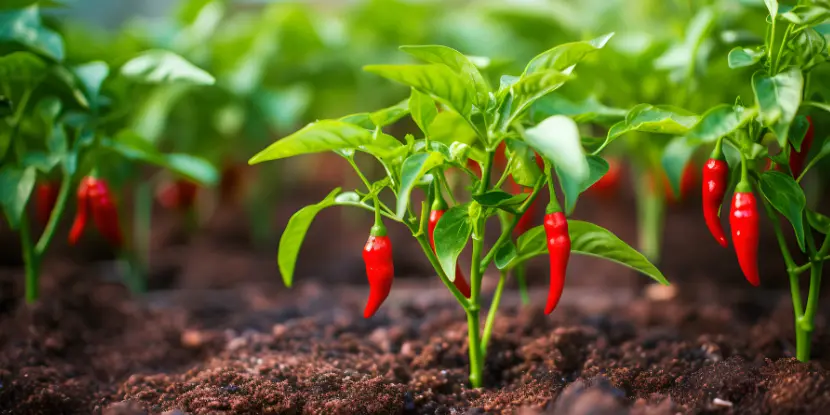
Young hot pepper plants in a garden.
Pepper Varieties
Hot pepper varieties require more days to mature. The flavor is measured in Scoville units, where the higher the number is, the hotter the pepper. Some mild varieties with about 3,000 units are:
- Anaheim Chilies
- Ancho (Poblano)
- Garden Salsa
- Paprika
- Jalapeno
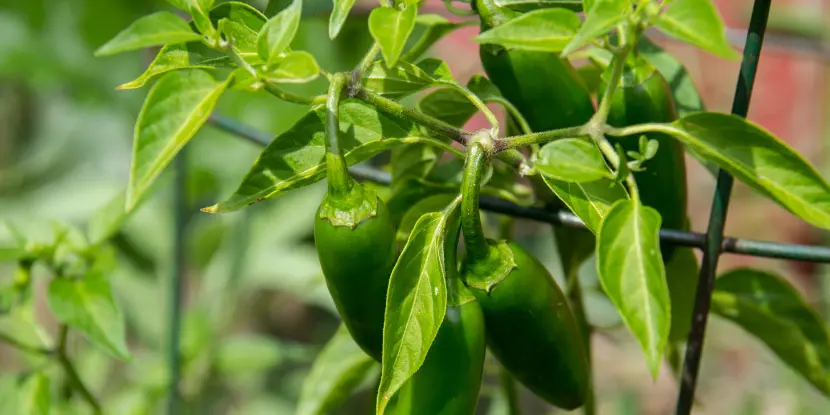
A jalapeño pepper plant with fruit.
Medium-hot varieties:
- Hot Banana
- Cascabel
- Jalapeno (Chipoties)
- Pasillas
- Rocotillo.

Red hot banana peppers in basket.
Hot varieties:
- Chili de Arbol
- Serran
- Hot Yellow Wax are hot varieties
Very pungent:
- Cayennes
- Chiltepin (Piquin)
- Tabasco are very pungent

A red chili pepper plant grows in a greenhouse.
Extremely hot:
- Chiltepin
- Habaneros (215,000 units)
- Jamaica Scotch Bonnet
- Thai Dragon
I have two specialty seed catalogs that list 39 bell, 25 non-bell, and 76 hot pepper varieties.
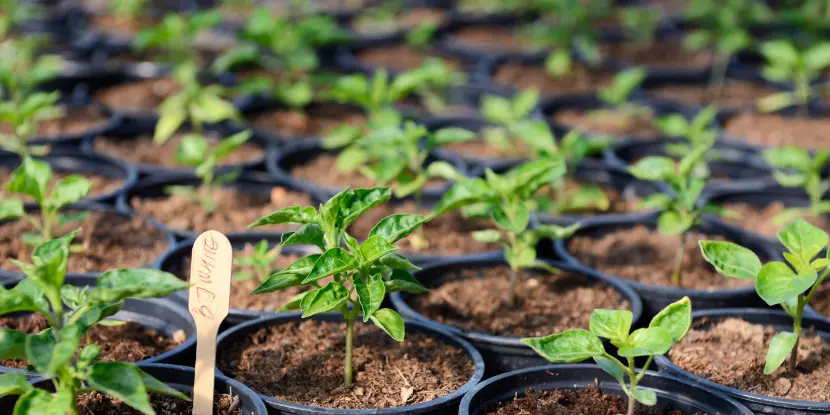
Hot pepper saplings in a greenhouse.
Soil Conditions for Peppers
- Soil temperature needs to be 80 to 90 degrees F to germinate seeds. Peppers need about 50 percent more time than tomato seeds.
- Soil pH between 6.0 and 7.0 is optimal for growth.
- The soil should be rich in organic matter; consider adding compost or well-rotted manure.
- Prior to planting, loosen and aerate the soil to encourage root development.
- Mix a balanced fertilizer into the soil before planting to provide essential nutrients.
- Incorporate coarse sand or fine gravel into the soil to enhance its draining capabilities.
- Planting on a slight slope naturally facilitates water drainage.
- Ensure the garden bed receives full sun exposure. Peppers thrive in sunny conditions.
Temperature
Peppers need nighttime temperatures above 65 degrees and daytime temperatures less than 80 to 90 degrees F to develop fruit.
If air and/or soil temperatures are lower, the young plants may be stunted.
If daytime temperatures are above 90 degrees F, the plants will drop their blossoms.
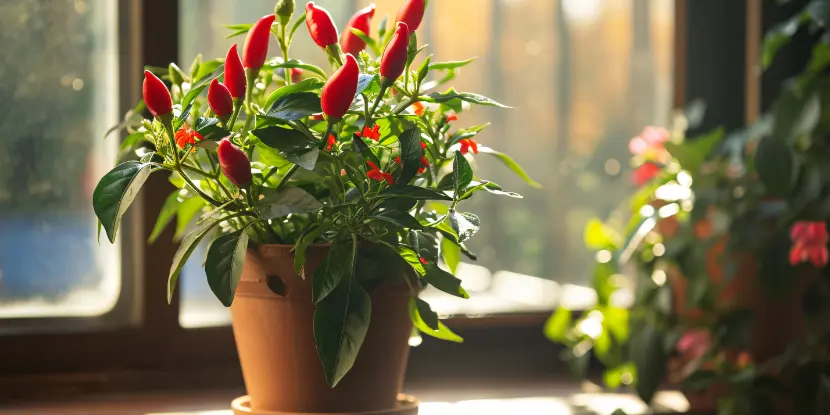
Hot peppers growing in a terra-cotta pot.
Planting Peppers
Starting from Seed
- Start seeds indoors 8–10 weeks before the last expected frost date.
- Fill seed-starting trays or small pots with a seed-starting mix.
- Sow seeds about 1/4 inch deep. Lightly cover with soil and water gently.
- Maintain soil temperature between 80 and 90 degrees Fahrenheit. Use a heat mat if necessary.
- Provide 12–16 hours of light daily using grow lights, as natural sunlight may be insufficient.
- Keep the soil moist but not soggy. Use a spray bottle to avoid displacing seeds.
- Gradually acclimate seedlings to outdoor conditions over 7–10 days by placing them outdoors for increasing periods each day.
Transplanting Pepper Plants
Pepper plants should be moved to the outside two to four weeks later than tomato plants. They’re easy to grow in 5-gallon containers with wire cages to prevent wind damage. Pepper stems are brittle and break easily.
- Ensure the soil is rich in organic matter and well-drained. Rake the surface smooth and remove any weeds or debris.
- Space transplants 18–24 inches apart in rows 24–36 inches apart.
- Dig a hole large enough to accommodate the root ball. Place the transplant in the hole, burying it at the same depth as it was in the pot.
- Water thoroughly after planting to help settle the soil around the roots.
- Apply a layer of mulch around the base of the plants to retain moisture and suppress weed growth.
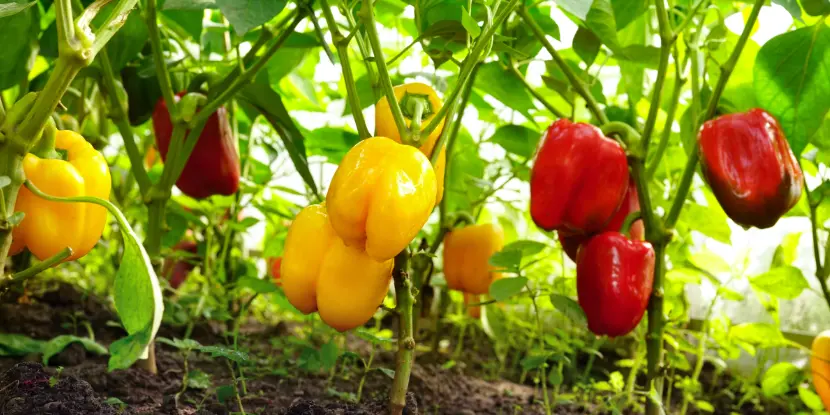
Ripe bell peppers in the garden.
General Care
Watering Pepper Plants
- Keep the soil consistently moist but not saturated. Overwatering can lead to root rot and other issues.
- Check the soil moisture by inserting your finger about an inch into the soil. If it feels dry at this level, it’s time to water.
- Water deeply once or twice a week, depending on weather conditions.
- Consider deploying soaker hoses or drip irrigation to deliver water directly to the root zone, preventing foliage diseases caused by wet leaves.
- Apply a layer of mulch around the base of the plants to retain soil moisture and slow evaporation.
- Water your pepper plants early in the day to ensure the foliage dries off quickly, reducing the risk of fungal infections.
Fertilizing Pepper Plants
- Prior to planting, incorporate a balanced, slow-release fertilizer into the soil. This provides essential nutrients as the young plants establish themselves.
- Once the plants have settled for about 2–3 weeks, apply a side dressing of high-nitrogen fertilizer to foster initial growth. Follow the manufacturer’s recommended dosage.
- Apply a balanced fertilizer every 4–6 weeks to sustain plant development. Formulations like 5-10-10 or 10-10-10 work well. Apply it in a band around the plants, avoiding direct contact with the stems.
- During the growing season, supplement with a liquid fertilizer, such as fish emulsion or seaweed extract, every 2–3 weeks. This provides micro-nutrients and enhances overall plant vigor.
- Excess nitrogen can promote lush foliage at the expense of fruit production. Monitor plant response and adjust fertilization accordingly.

Sweet peppers ready to for harvest.
Controlling Pests & Diseases
- Peppers are relatively pest-resistant, but aphids, cutworms, flea beetles, and spider mites may attack your plants. Use insecticidal soap or neem oil to control these pests.
- Remove and destroy any diseased plants immediately to prevent the spread to healthy ones. Common pepper diseases include bacterial spot, blossom end rot, and powdery mildew.
- Practice crop rotation every 3–4 years to reduce the risk of soil-borne diseases.
- For additional protection, use row covers or companion planting techniques to deter pests and attract beneficial insects.
Harvesting Peppers
- Peppers are ready for harvest when they reach full size and color. Most varieties mature in 65–100 days.
- Use a sharp knife or scissors to cut the peppers from the plant, leaving a short stem intact. Pulling or twisting may damage the plant.
- Handle peppers gently. They bruise easily.
- Leave some peppers on the plant longer to fully ripen, which will enhance their sweetness.
- Be aware that hot pepper varieties can cross-pollinate, resulting in unexpected heat levels.
- Harvest regularly to encourage continued fruit development throughout the season.

Hot peppers growing in a terra-cotta pot.
FAQs: Growing Pepper Plants
Q: What’s the best time to plant peppers in Southern California?
Plant your hot peppers after the last frost in spring, typically from March to April, when the soil temperature reaches at least 65°F.
Q: Can I grow peppers in pots?
Peppers thrive in pots with proper drainage. Use a pot size of at least 3 gallons for optimal growth.
Q: How much sunlight do peppers need?
Pepper plants need at least 6 to 8 hours of direct sunlight daily. In Southern California’s sunny climate, this requirement is easily met.
Q: How often should I water my pepper plants?
Water pepper plants deeply once the top inch of soil feels dry. In the hotter months, this might mean watering every day or two.
Q: What kind of soil is best for growing peppers?
Hot peppers prefer well-draining, loamy to sandy soil with a pH between 6.0 and 7.0.
Q: Do hot peppers need fertilizer?
Fertilize your hot peppers with a balanced, slow-release fertilizer at planting, and then switch to a high-potassium fertilizer once they start flowering and setting fruit.
Q: How should I deal with pests on my hot pepper plants?
In Southern California, common pests include aphids and spider mites. For organic control, apply insecticidal soap or neem oil.
8. Can hot weather affect pepper plants?
Extreme heat above 90°F can affect flower pollination. To prevent this, provide partial shade during the hottest part of the day.
Q: When are peppers ready to harvest?
Usually 65–100 days after transplanting. Look for firm, brightly colored, fully-sized peppers.
Q: How can I increase the heat level of my hot peppers?
Stressing the plants slightly by reducing water or increasing sun exposure can lead to hotter peppers. However, don’t over-stress them, as this can harm the plant.

